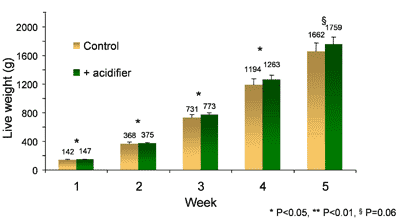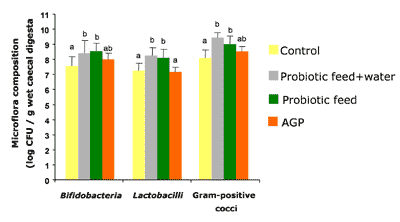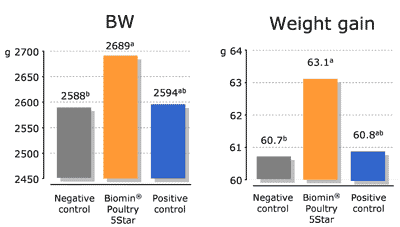Health Management in Poultry
Gut Health Management in Poultry: Update on Natural Growth Promoters

The ban of antibiotics in Europe has driven worldwide the implementation of alternative strategies in order to prevent proliferation of pathogenic bacteria, thus maintaining health and performance status and optimizing digestion in poultry. Several approaches have been developed to directly affect microbial communities in the digestive tract. The primary strategy is to prevent the gut from pathogenic invasion by preservation of feed with suitable acidifiers, which may, in addition, have a positive impact on growth performance. Moreover, rapid establishment of a beneficial gut microflora can be achieved by supplementation of probiotics, especially in the early stage of life or after antibiotic medication. Administration of prebiotic carbohydrates and phytogenic feed additives assists in maintaining a healthy gut microflora throughout the growth period. Finally, NSP-degrading enzymes are known to reduce digesta viscosity, thereby improving energy availability, nutrient digestibility and performance. Under practical conditions, combined strategies are recommended in order to optimize the use of Natural Growth Promoters (NGPs) in poultry nutrition.
Introduction
In the past decades, deficiencies in feed formulation and management practice have been masked by the routine use of Antibiotic Growth Promoters (AGPs). However, the ban of AGPs in Europe has driven the implementation of alternative strategies in order to prevent proliferation of pathogenic bacteria, thus maintaining health and performance status and optimizing digestion in poultry production. A stable gut microflora, predominantly composed of lactic acid-producing bacteria and protecting the host from pathogenic invasion, is a prerequisite for gut health and adequate growth performance. Several feed additives have been used to manipulate microbial communities in the digestive tract. However, their efficacy has not always been proven and their modes of action require further research.
The present paper focuses on the role of Natural Growth Promoters (NGPs) as potential modulators of gut health and growth performance in modern poultry production.
Feed preservation: Acidifiers
Even under good hygienic conditions, feedstuffs contain a certain number of moulds, bacteria and yeasts. Some mould species (e.g. Aspergillus, Penicillium, Fusarium) are known to produce mycotoxins, which may negatively affect health and growth performance (Leeson et al., 1995). Acidifiers may well be used to avoid microbial deterioration of feed during storage. Moreover, increased growth performance has been observed when acidifiers have been added to feed (Lückstädt et al., 2004; Skinner et al., 1991). The positive impact of dietary acidifiers on gut health and growth performance has been attributed to (1) a reduction of the pH values in the feed and digestive tract, serving as a barrier against pathogenic microorganisms which are sensitive to low pH values, (2) direct antimicrobial effect, and (3) reduction in buffering capacity in conjunction with increased protein digestibility (Roth and Kirchgessner, 1995).
The efficiency of organic acids largely depends on their pKa value, which is the pH value at which 50% of the acid is dissociated. Low pKa values (e.g. citric, formic acid) generally indicate a strong pH-decreasing impact, whereas a pronounced antimicrobial effect is obtained at higher pKa values (e.g. propionic, butyric acid). The combination of acidifiers with different pKa values may, therefore, exert synergistic effects and maximise the beneficial impact of supplementation with organic acid on gut health and growth performance (Piva et al., 2002).
Few studies have been carried out so far that investigated the efficacy of acidifiers as NGP in poultry nutrition (Lückstädt et al., 2004; Skinner et al., 1991; Vogt et al., 1981). Lückstädt et al. (2004) examined the efficacy of a blend of propionic acid and formic acid based on an inorganic phyllo-silicate carrier (Biotronic®) in broilers. As shown in Figure 1, the acidifier significantly increased live weight throughout the experiment.
 |
| Figure 1.Effect of an acidifier (Biotronic®) on live weight in broilers (n = 120) (Lückstädt et al., 2004) |
Establishment of a beneficial gut microflora: Probiotics, prebiotics and synbiotics
Immediately after birth, the gut of neonate chicks is getting colonised by a large number of microorganisms originating from the environment. Age and physiological state of the birds as well as the dietary composition may affect the gut microflora, both in quantitative and qualitative terms.
Oral administration of beneficial bacteria (probiotics) assists in rapidly establishing a beneficial gut microflora, which is generally characterized by high levels of lactic acid-producing bacteria. The beneficial impact of probiotics is attributed to (1) competition with pathogens for nutrients and adhesion sites, (2) production of antagonistic substances such as lactoferrin, lysozyme, hydrogen peroxide, lactic acid or other organic acids, and (3) immune modulation through induction of cytokines or stimulation of macrophages and antibodies (Perdigon et al., 2001).
Establishment of a beneficial gut microflora largely depends on the dietary ingredient composition. Several carbohydrates (prebiotics), which are resistant to host digestive enzymes, have been shown to stimulated growth of beneficial bacteria such as Bifidobacteria or Lactobacilli (Hartemink and Rombouds, 1997). Such carbohydrates include, among others, inulin, fructo-oligosaccharides (FOS) or galacto-oligosaccharides. In studies with 240 day-old broilers (Xu et al., 2003), FOS increased the growth rates of Bifidobacteria and Lactobacilli and also inhibited E. coli in the small intestine and caeca of broiler chicks. In this study, birds were fed a corn-soybean meal-based diet which was supplemented with graded doses of FOS (0, 2, 4 or 8 g/kg of finished feed) at the expense of corn.
Moreover, addition of FOS increased activities of endogenous amylase and protease, as well as jejunal and ileal microvillus height and, finally, improved body weight gain and feed conversion ratio. The improvements were maximal in magnitude when FOS was added at 4 g/kg, indicating a distinct dose-dependency of the parameters that were investigated. In a study with turkeys, Juskiewicz et al. (2005) reported that dietary supplementation of inulin significantly reduced the population of E. coli in the caeca and tended to increase numbers of Bifidobacteria and Lactobacilli.
A synergistic effect may be expected if probiotics and prebiotic carbohydrates are administrated in combination (Roberfroid, 1998). Nemcova et al. (1999) investigated the effect of a probiotic alone or in combination with FOS on the composition of the faecal microflora in piglets. Dietary supplementation of Lactobacillus paracasei alone decreased the faecal counts of Clostridia and Enterobacteriaceae. Moreover, the combined administration of Lactobacilli and FOS increased faecal counts of Lactobacilli, Bifidobacteria, total anaerobes and total aerobes and reduced levels of Clostridia and Enterobacteriaceae.
The impact of synbiotics in comparison to AGPs on gut microflora of broilers has been demonstrated by Mountzouris et al. (2006, Figure 2). In total 400 day old broilers were fed corn-soybean meal-based diets with or without supplementation of either a multi-strain probiotic feed additive based on Lactobacilli, Bifidobacteria, Enterococcus and Pediococcus (Biomin® Poultry5Star) or a commercial AGP (Avilamycin). Compared to the control and AGP treatment, the probiotic additive significantly increased the numbers of Bifidobacteria, Lactobacilli and Gram-positive cocci. Moreover, growth performance in birds fed supplemental synbiotics was similar (P > 0.05) as compared to birds fed the AGP.
 |
| Figure 2.Impact of synbiotics and an antimicrobial growth promoters (AGP) on caecal counts of different bacterial species (adapted from Mountzouris et al., 2006) |
The effect on growth performance of the same commercial synbiotic preparation was investigated in a study with 200 day-old broilers (Mohnl et al., 2006). Administration of the synbiotic in the drinking water significantly improved live weight (4%) and daily weight gain (4%) (Figure 3) and numerically reduced mortality rate (48 %).
 |
| Figure 3.Effect of a commercial synbiotic preparation on performance parameters in broilers |
Phytogenics
A comparatively new category of NGPs originating from herbs and spices has been receiving growing attention in the past few years. Phytogenics are extremely inhomogeneous regarding their ingredient composition and levels of active substances. Phytogenic components such as carvacrol, thymol or cinnamaldehyde have strong antimicrobial, antioxidant and flavouring properties. Moreover, it has been speculated that phytogenics may stimulate secretion of saliva and digestive enzymes (Lee et al., 2004). The impact of a blend of essential oils originating from oregano, clove and anise in comparison to a conventional AGP (Avilamycin) was investigated in a trial with broilers (Ertas et al., 2005).
The phytogenic, fed at graded doses (0, 100, 200, 400 ppm), significantly improved average daily weight gain and gain:feed ratio and these improvements were even higher in magnitude in comparison to the AGP. The effects of phytogenic supplementation were highest at a dosage of 200 ppm, indicating a close dose-dependency between performance parameters and the level of supplemental phytogenics. Additionally, there was an increase in feed intake following administration of the phytogenic after three experimental weeks. In a 120-d trial with broilers, the combined administration of acidifiers and phytogenics increased weight gain and reduced feed:gain ratio in comparison with a control treatment (Figure 4).
 |
| Figure 4.Effect of an acidifier and phytogenics on performance parameters in broilers |
Feed enzymes
Barley, oats, rye, triticale or wheat contain significant amounts of soluble Non-Starch Polysaccharides (NSP). Inclusion of these grains in diets for poultry produces sticky droppings and poor litter quality. Thus, enzymes specifically tailored to decrease gut viscosity (e.g. β-glucanases, xylanases, pectinases, cellulases and others) are recommended in diets for broilers, layers and turkeys. Supplementation of cereal-based diets with NSP-degrading enzymes which target the soluble NSP fraction results in a decrease in digesta viscosity and water-holding capacity (Dänicke, 1999). Consequently, the transit of digesta in the gut is accelerated, which, in turn, may stimulate voluntary feed intake.
It is assumed that a reduction in digesta viscosity improves the rate of diffusion between host digestive enzymes (proteases, lipases, amylases) and nutrients, resulting in increased nutrient digestibility and energy availability. As reported by Meng et al. (2004), supplementation of wheat-based control diets with an enzyme cocktail containing β-glucanase, xylanase, cellulase and other side activities significantly reduced digesta viscosity in the jejunum of broilers (2.5 vs. 5.0 mPa s).
Moreover, addition of NSP-degrading enzymes significantly reduced the concentration of soluble and insoluble NSP in the digesta of broilers, thereby improving ileal digestibilities of NSP, fat, starch and nitrogen. In studies with broilers (Choct et al., 2004), supplementation of wheat-based diets with xylanase preparations originating from different fungal sources improved average daily weight gain and feed conversion rate by 4–14 and 4–9%, respectively. However, the response of these parameters clearly depended on the origin of the supplemental enzymes, indicating differences in substrate specificity between different sources of NSP-degrading enzymes.
Conclusion
Several feeding strategies may be implemented to assist in promoting health and performance status in poultry production. Acidification of diets prevents microbial contamination and may stimulate growth performance. Combined administration of probiotics and prebiotics has the potential to accelerate the establishment of a beneficial gut microflora, which protects the host from invasion by pathogens. Supplementation of diets with specific NSP-degrading enzymes improves litter quality as well as nutrient and energy digestibilities. The use of phytogenics may stabilize the gut microflora to a certain extent. Most of the effects of the Natural Growth Promoters depend on the age of the animals as well as on the dosages at which these ingredients are included in the feed.
References
Choct, M., Kocher, A., Waters, D.L.E., Pettersson, D., Ross, G. (2004) A comparison of three xylanases on the nutritive value of two wheats for broiler chickens. Br. J. Nutr. 92, 53–61.
Dänicke, S. (1999) Zum Einfluß von Nicht-Stärke-Polysacchariden (NSP) und NSP-spaltenden Enzymen auf die Passagezeit der Ingesta sowie den Energie- und Proteinumsatz von wachsenden Schweinen und Broilern. Übers. Tierernähr. 27, 221–273.
Ertas, O.N., Güler, T., Çiftçi, M., DalkIlIç, B., Simsek, Ü.G. (2005)The effect of an essential oil mix derived from oregano, clove and anise on broiler performance. Int.J.Poult. Sci. 4, 879–884.
Hartemink, R., Rombouts, F.M. (1997) Gas formation from oligosaccharides by the intestinal microflora. In: Non-Digestible Oligosaccharides: Healthy Food for the Colon? Proceedings of an International Symposium. Edited by Hartemink, R., Graduate School VLAG, Wageningen Institute of Animal Science, Wageningen, The Netherlands. Pp. 57–66.
Juskiewicz, J., Jankowski, J., Zdunczyk, Z., Biedrzycka, E., Koncicki, A. (2005) Performance and microbial status of turkeys fed diets containing different levels of inulin. Arch. Geflügelkd.69, 175–180.
Lee, K.-W., Everts, H., Beynen, A.C. (2004) Essential oils in broiler nutrition. Int. J. Poult. Sci. 3, 738–752.
Leeson, S., G. J. Diaz, J. D. Summers. 1995. Trichothecenes. In: Poultry Metabolic Disorders and Mycotoxins. University Books, Guelph, Ontario, Canada. Pp. 190–226.Lückstädt, C., Şenköylü, N., Akyürek, H., Aĝma, A. (2004) Acidifier – a modern alternative for anti-biotic free feeding in livestock production, with special focus on broiler production. Veterinarija ir Zootechnika 27, 91–93.
Meng, X., Slominski, B.A., Guenter, W. (2004) The effect of fat type, carbohydrase, and lipase addition on growth performance and nutrient utilization of young broilers fed wheat-based diets.Poult. Sci. 83, 1718–1727.
Mountzouris, K.C., Beneas, H, Tsirtsikos, P, Kalamara, E., Fegeros, K. (2006) Efficacy of a new multi-strain probiotic product in promoting broiler performance and modulating the composition and activities of cecal microflora. 2006 International Poultry Scientific Forum, Atlanta, Georgia. P. 59.
Nemcova, R., Bomba, A., Gancarcikova, S., Herich, R., Guba, P. (1999) Study of the effect of Lactobacillus paracasei and fructooligosaccharides on the faecal microflora in weanling piglets. Berl. Münch. Tierärztl. Wschr. 112, 225–228.
Perdigón, G., Fuller, R., Raya, R. (2001) Lactic acid bacteria and their effect on the immune system. Current Issues in Intestinal Microbiology 2, 27–42.
Piva, A., Casadei, G., Biagi G. (2002) An organic acid blend can modulate swine intestinal fermentation and reduce microbial proteolysis. Can. J. Anim. Sci. 82, 527–532.
Roberfroid, M.B. (1998) Prebiotics and synbiotics: concepts and nutritional properties. Br. J. Nutr. 80 (Suppl. 2), S197–S202.
Roth, F.X., Kirchgessner, M. (1995) Zum Einsatz von Ameisensäure in der Tierernährung. 5. Forum Tierernährung, BASF AG, Ludwigshafen, Germany, pp. 5-20.
Skinner, J.T., Izat, A.L., Waldroup, P.W. (1991) Research note: Fumaric acid enhances performance of broiler chickens. Poult. Sci. 70, 1444–1447.
Vogt, H., Matthes, S., Harnisch, S. (1981) Der Einfluß organischer Säuren auf die Leistungen von Broilern und Legehennen. Arch. Geflügelkd. 45, 221–232.
Xu, Z.R., Hu, C.H., Xia, M.S., Zhan, X.A., Wang, M.Q. (2003) Effects of dietary fructooligosaccharide on digestive enzyme activities, intestinal microflora and morphology of male broilers. Poult. Sci. 82, 1030–1036.
Authors:
Tobias Steiner / BIOMIN GmbH, Industriestrasse 21, 3130 Herzogenburg, Austria.
Kurt Wegleitner/ BIOMIN Laboratory Singapore Pte. Ltd., 3791 Jalan Bukit Merah #08-08, E-Centre@Redhill, Singapore 159471.








.jpg&w=3840&q=75)